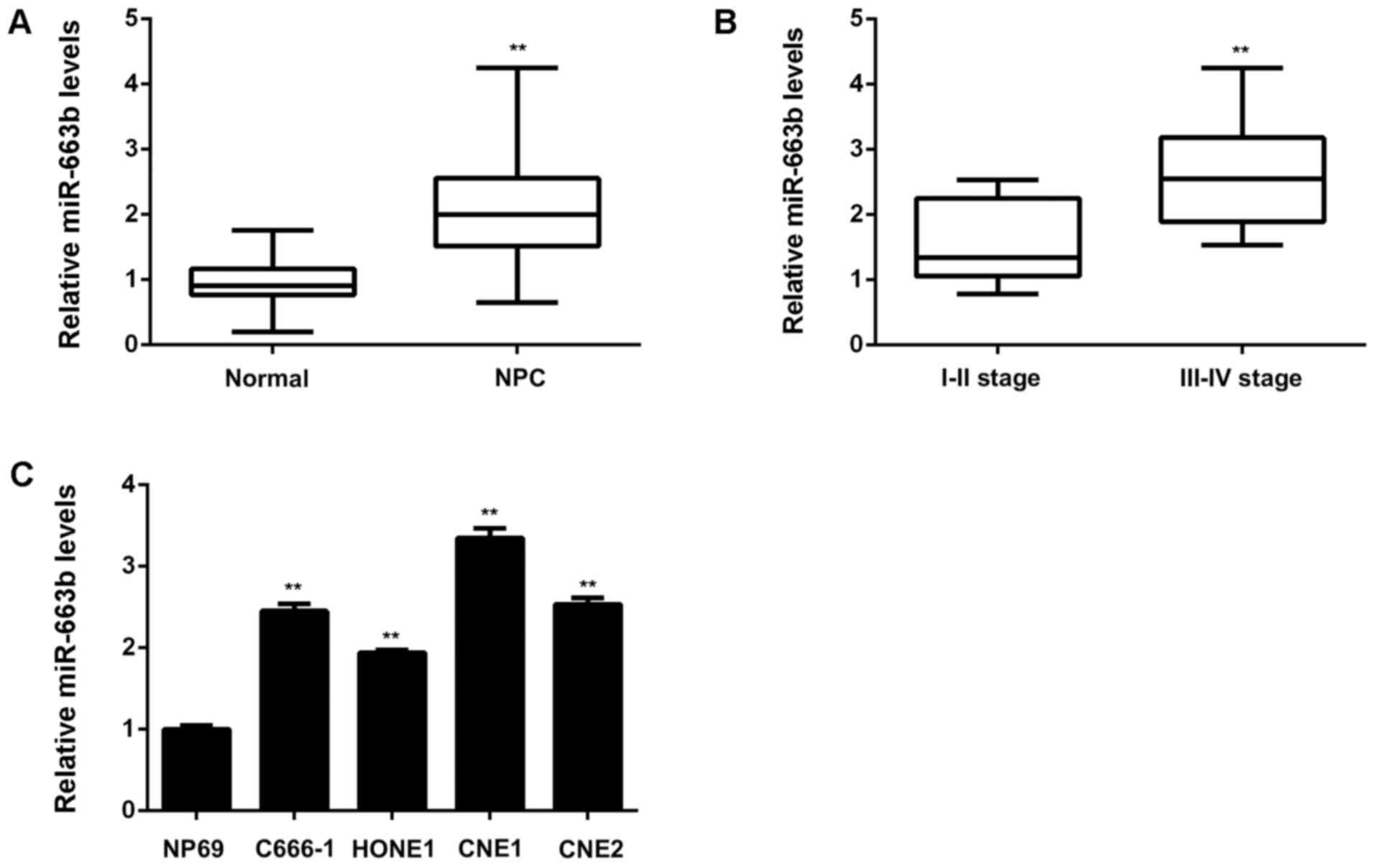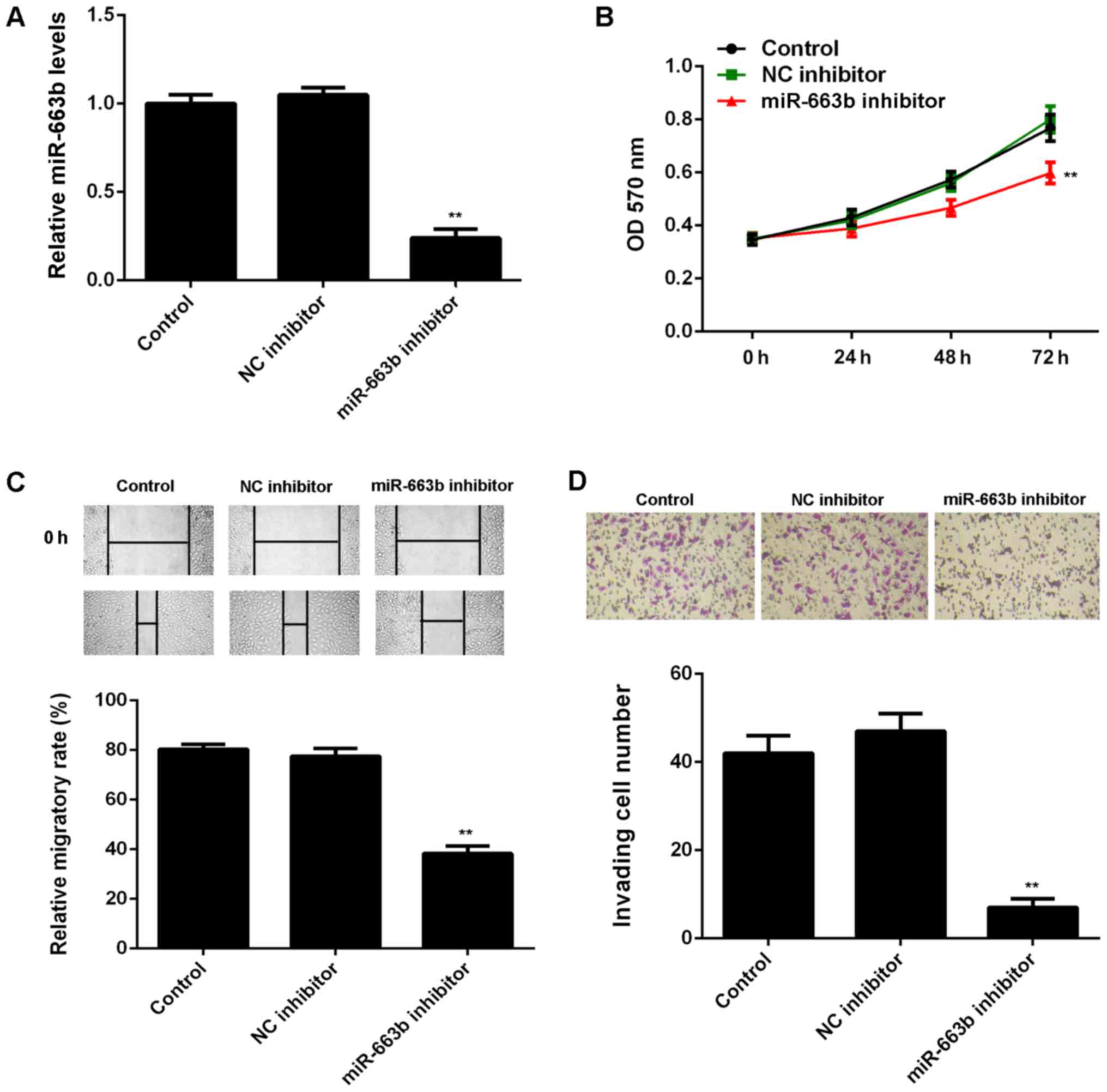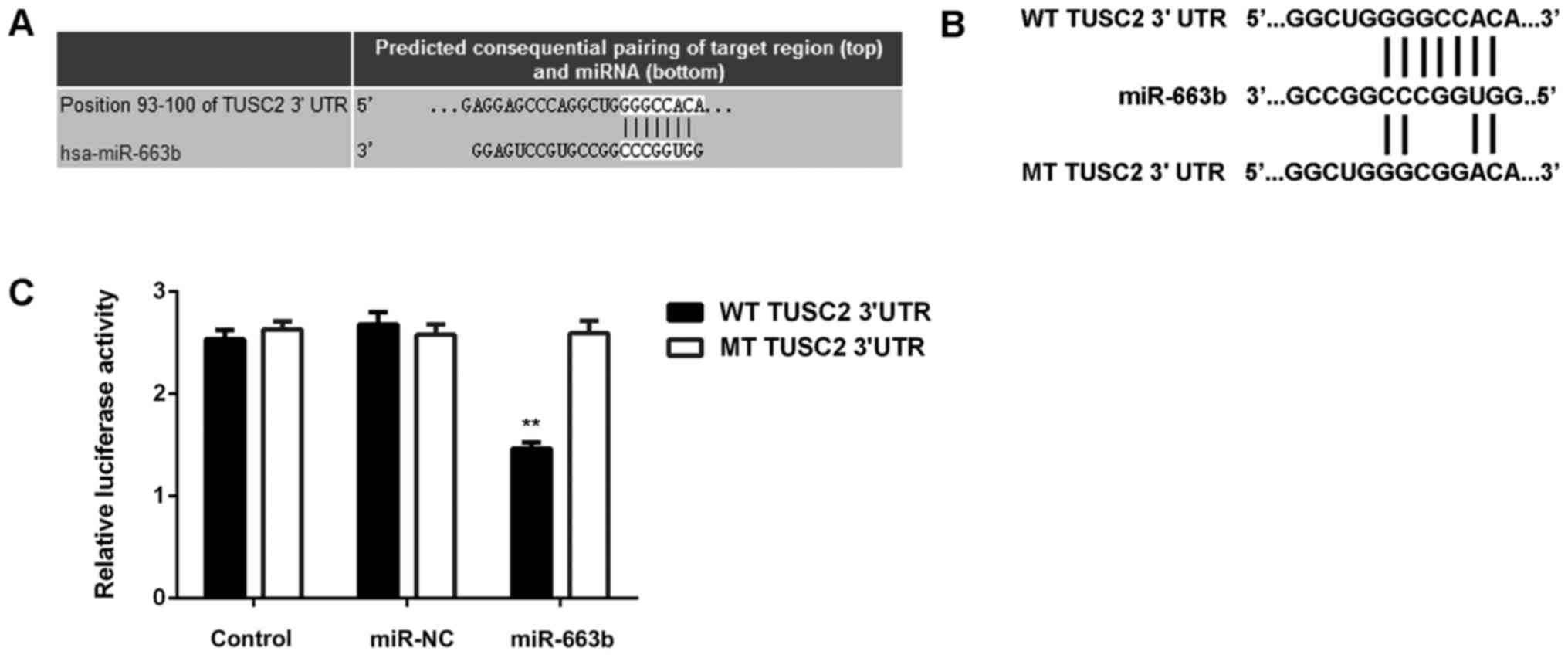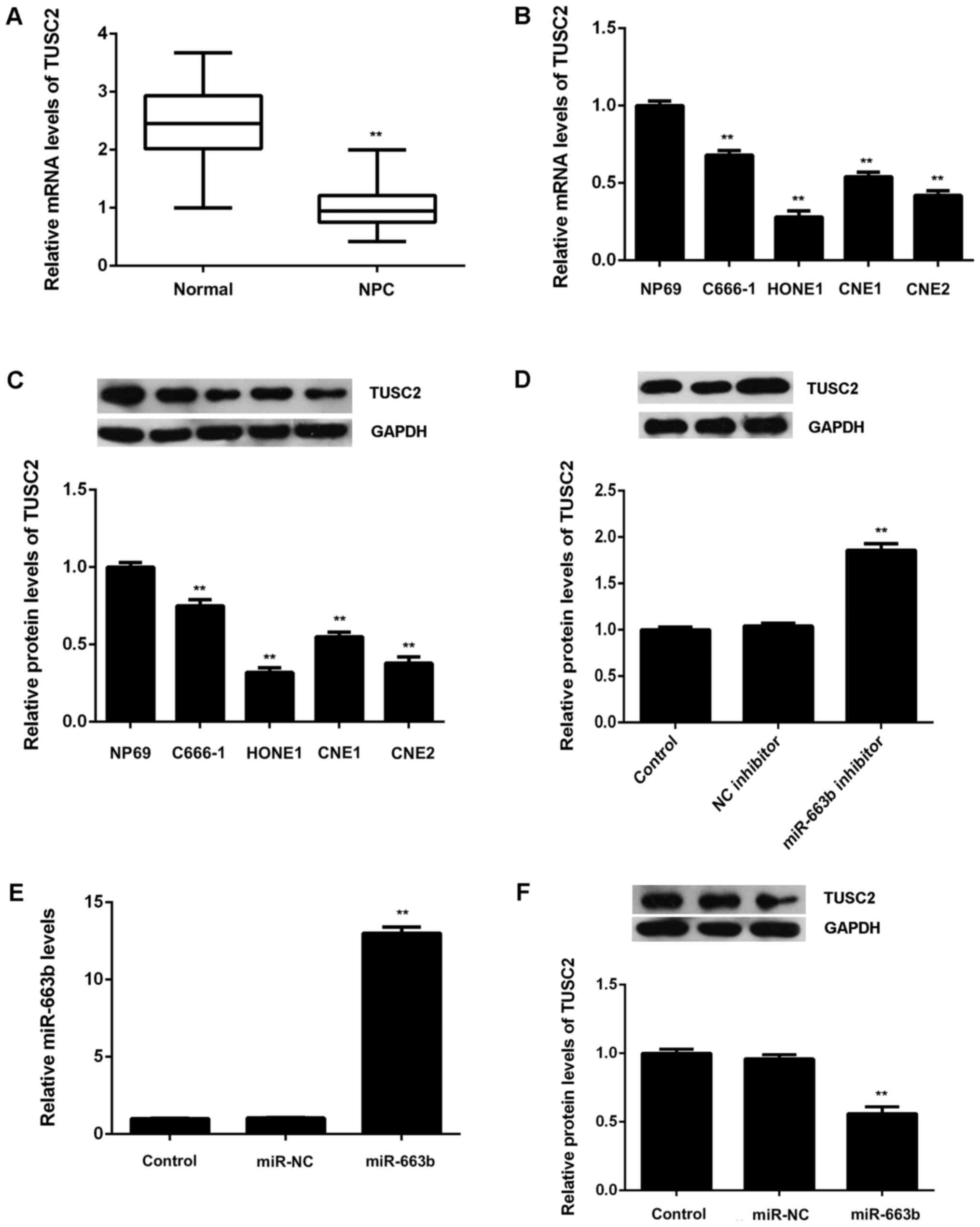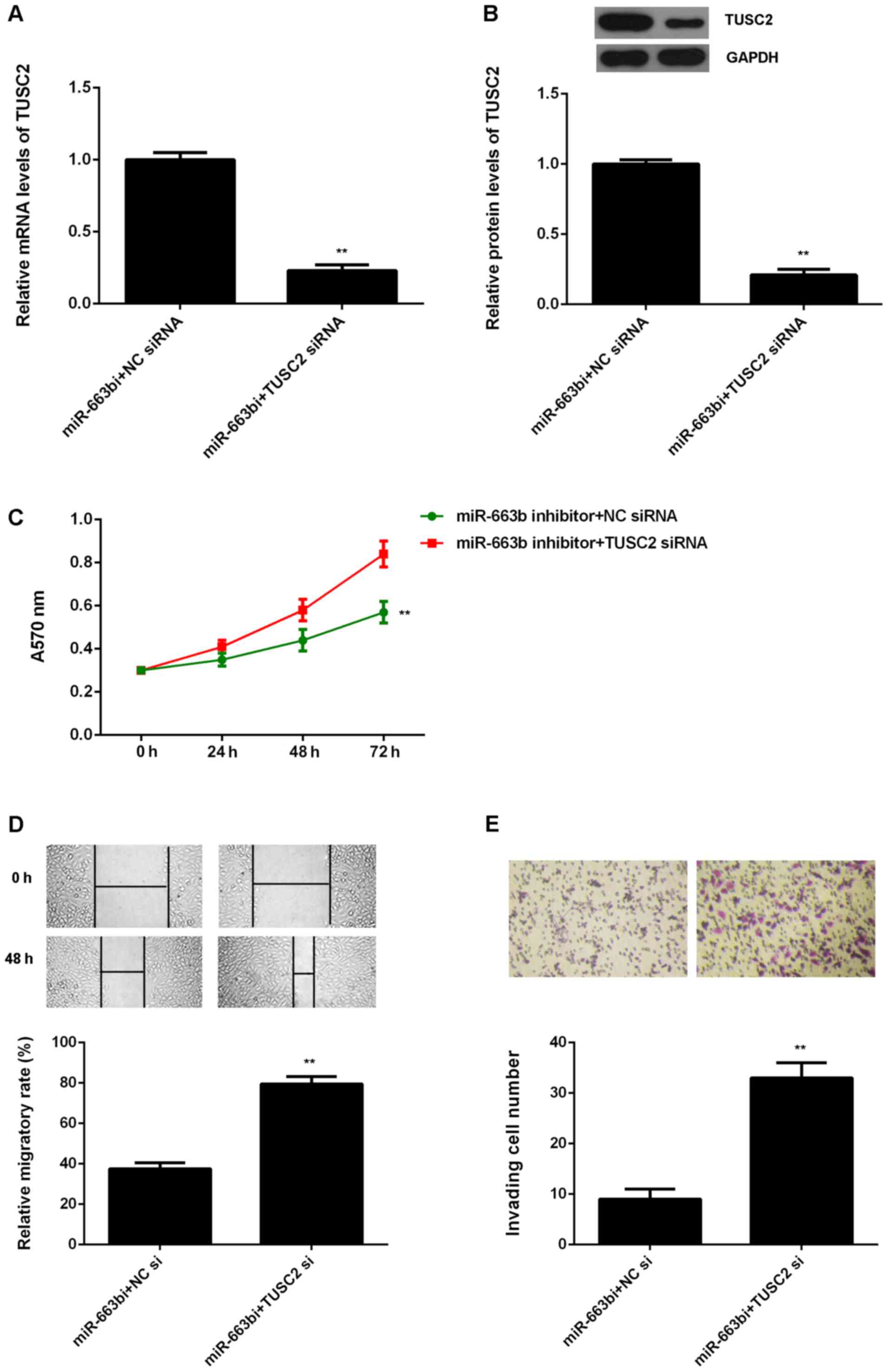miR-663b promotes tumor cell proliferation, migration and invasion in nasopharyngeal carcinoma through targeting TUSC2
Retraction in: /10.3892/etm.2021.10883
- Authors:
- Published online on: June 14, 2017 https://doi.org/10.3892/etm.2017.4608
- Pages: 1095-1103
-
Copyright: © Liang et al. This is an open access article distributed under the terms of Creative Commons Attribution License.
Abstract
Introduction
Nasopharyngeal carcinoma (NPC), mainly due to genetic susceptibility and Epstein-Barr virus (EBV) infection, is a common head and neck cancer with very high prevalence in Southeast Asia and Southern China (1–3). Although NPC at early stage is highly radiocurable, the outcomes of patients with locoregionally advanced NPC is poor (4,5). Therefore, revealing the underlying mechanisms of NPC growth and metastasis is urgently needed, which may help develop effective therapeutic strategy for the treatment of NPC.
MicroRNAs (miRs) are a class of small non-coding RNAs, and have been demonstrated to act as key gene regulators through directly binding to 3′ untranslated regions (3′UTRs) of their target mRNAs, which further leads to mRNA degradation or translation inhibition (6–8). It has been well-established that miRs play important roles in the regulation of cell proliferation, differentiation, apoptosis, migration, invasion, and so forth (9–11). Moreover, many miRs have been reported to direct target oncogenes or tumor suppressors, and thus play suppressive or promoting roles in human cancers (10,12–14). In recent decade, deregulations of specific miRs have been implicated in NPC development and progression, such as miR-15a, miR-138, miR-214, miR-218, and miR-663b (15–19). Yi et al reported that inhibition of miR-663 suppressed the proliferation of NPC CNE1 and 5-8F cells in vitro, and the NPC tumor growth of xenografts in nude mice (19). However, the molecular mechanism of miR-663b in the regulation of the malignant phenotypes of NPC cells still remains to be fully studied.
Tumor suppressor candidate 2 (TUSC2), is also known as FUS1 in chromosome 3p21.3 region, and has been demonstrated to act as a tumor suppressor (20). Many allele losses and genetic alterations are observed in some common cancer types, such as breast cancer, lung cancer and so forth (20–22). For instance, Xin et al reported that TUSC2 acted as a tumor-suppressor gene by upregulating miR-197 in human glioblastoma (23). Recently, Zhou et al showed that TUSC2 was among the 8 downregulated genes associated with cell apoptosis in the chromosome deletion regions according to the NPC gene chip data (24). However, the expression pattern of TUSC2 as well as the regulatory mechanism underlying TUSC2 expression in NPC still remains obscure.
Therefore, the present study aimed to examine the expression of miR-663b in NPC tissues compared with non-tumor tissues, and then investigate the molecular mechanism of miR-663b underlying NPC cell proliferation, migration and invasion.
Materials and methods
Tissue collection
Our study was approved by the Ethics Committee of Tumor Hosipital of First People's Hospital of Foshan, Foshan, China. We collected 67 cases of NPC tissues and 13 non-tumor nasopharyngeal epithelial tissues at our hospital from April 2014 to March 2016. The written consents have been obtained. The clinical charicteristics of NPC patients was summarized in Table I. The tissue samples were stored at −80°C before use.
Table I.Association between miR-663b expression and clinicopathological characteristics of patients with nasopharyngeal carcinoma. |
Cell culture
Four NPC cell lines (C666-1, HONE1, CNE1, and CNE2) and a normal nasopharyngeal epithelial cell line NP69 were obtained from the Cell Bank of Chinese Academy of Sciences (Shanghai, China). All cell lines were cultured in Dulbecco's Modified Eagle's Medium (Thermo Fisher Scientific, Inc., Waltham, MA, USA) added with 10% fetal bovine serum (FBS; Thermo Fisher Scientific, Inc.) in a 37°C humidified atmosphere of 5% CO2.
Cell transfection
For transfection, CNE1 cells were transfected with negative control (NC) inhibitor (GeneCopoeia, Inc., Rockville, MD, USA), miR-663b inhibitor (GeneCopoeia, Inc.), scramble miR mimic (GeneCopoeia, Inc.), miR-663b mimic (GeneCopoeia, Inc.), or co-transfected with miR-663b inhibitor and NC siRNA (Yearthbio, Changsha, China), or miR-663b inhibitor and TUSC2 siRNA (Yearthbio) using Lipofectamine® 2000 (Thermo Fisher Scientific, Inc.), according to the manufacturer's recommendation.
Quantitative PCR assay
Total RNA was extracted from cells by using TRIzol Reagent (Thermo Fisher Scientific, Inc.), which was then converted into cDNA using a Reverse Transcription kit (Thermo Fisher Scientific, Inc.), according to the manufacturer's instruction. The miR-663b levels were examined by real-time RT-PCR using PrimeScript® miRNA RT-PCR kit (Takara Bio, Dalian, China) on ABI 7500 thermocycler (Thermo Fisher Scientific, Inc.). U6 was used as an internal reference. The primers for miR-663b and U6 were purchased from Kangbio (Shenzhen, China). The mRNA expression of TUSC2 was detected by qPCR using the standard SYBR-Green RT-PCR kit (Takara Bio). GAPDH was used as an internal reference. The primer sequences for TUSC2 were forward: 5′-GGAGACAATCGTCACCAAGAAC-3′; reverse: 5′-TCACACCTCATAGAGGATCACAG-3′. The primer sequences for GAPDH were forward: 5′-CTGGGCTACACTGAGCACC-3′; reverse: 5′-AAGTGGTCGTTGAGGGCAATG-3′. The reaction condition was 95°C for 5 min, followed by 40 cycles of denaturation at 95°C for 15 sec and annealing/elongation step at 60°C for 30 sec. The relative expression was analyzed by the 2−ΔΔCq method (25).
Western blotting
Cells were solubilized in cold RIPA lysis buffer (Thermo Fisher Scientific, Inc.) to extract protein, which was separated with 10% SDS-PAGE (Thermo Fisher Scientific, Inc.), and transferred onto a polyvinylidene difluoride membrane (PVDF; Thermo Fisher Scientific, Inc.). The PVDF membrane was incubated with rabbit anti-TUSC2 or anti-GAPDH monoclonal antibodies (Abcam, Cambridge, MA, USA), respectively, at room temperature for 3 h. After washed by PBST for 15 min, the membrane was incubated with the corresponding secondary antibody (Abcam) at room temperature for 1 h. Chemiluminent detection was conducted by using the ECL kit (Thermo Fisher Scientific, Inc.). The protein expression was analyzed by Image-Pro plus software 6.0, represented as the density ratio vs. GAPDH.
Cell proliferation analysis
CNE1 cells (5×104) were cultured in 96-well plates, each well with 100 µl of fresh serum-free medium with 0.5 g/l MTT (Sigma, St. Louis, MO, USA). After incubation at 37°C for 12, 24, 48 and 72 h, the medium was removed by aspiration and 50 µl of DMSO (Sigma) was added to each well. After incubation at 37°C for a further 10 min, the A570 of each sample was measured using a plate reader (TECAN Infinite M200; Tecan Group Ltd., Männedorf, Switzerland).
Cell migration assay
CNE1 cells were cultured to full confluence, and a plastic scriber was used to create wounds. CNE1C cells were then washed with PBS, and incubated in DMEM containing 10% FBS at 37°C for 48 h. After that, cells were photographed under an inverted microscope (Olympus, Tokyo, Japan).
Cell invasion assay
CNE1 cell suspension (300 µl, 5×105 cells/ml) was added into the upper transwell chambers pre-coated with matrigel (BD Biosciences, San Diego, CA, USA), while 300 µl of DMEM with 10% FBS was added into the lower chamber. CNE1 cells were then incubated at 37°C for 24 h. After that, CNE1 cells on the upper surface of the membrane were wiped out using a cotton-tipped swab. The filters were stained by crystal violet (Sigma), and photographed under an inverted microscope (Olympus).
Bioinformatics prediction and dual luciferase reporter assay
Targetscan software (www.targetscan.org/) was used to predicate the putative target genes of miR-663b. The wild type (WT) or mutant type (MT) of TUSC2 3′UTR were constructed by PCR and Quick-Change Site-Directed Mutagenesis kit (Stratagene, La Jolla, CA, USA), which was then inserted into the MCS in the psiCHECKTM-2 vector (Promega Corp., Madison, WI, USA), respectively. CNE1 cells were cultured to 70% confluence in a 24-well plate, and co-transfected with 100 ng of WT-TUSC2 or MT-TUSC2 vector, plus 50 nM of miR-663b mimics or scramble miR (NC) using Lipofectamine® 2000. The dual-luciferase reporter assay system (Promega Corp.) was used to determine the luciferase activities 48 h after transfection. Renilla luciferase activity was normalized to firefly luciferase activity.
Statistical analysis
Data are expressed as the mean ± SD. The association between the miR-663b expression and clinical characteristics of NPC patients was analyzed using chi-square test. The statistical correlation of data between groups was analyzed by student t test or one-way ANOVA. Statistical analysis was performed using SPSS 19.0 (IBM SPSS, Armonk, NY, USA). P<0.05 was considered to indicate a statistically significant difference.
Results
miR-663b is upregulated in NPC, associated with advanced clinical stage and lymph node metastasis
The miR-663b levels were firstly examined in a total of 67 cases of NPC tissues and 13 non-tumor nasopharyngeal epithelial tissues. As shown in Fig. 1A, the expression of miR-663b was significantly increased in NPC tissues compared to non-tumor tissues. Moreover, as indicated in Fig. 1B, the NPC cases with high clinical stage showed higher miR-663b levels compared with those with low clinical stage, suggesting that the increased expression of miR-663b may contribute to NPC progression. To further confirm these findings, we studied the association between the miR-663b expression and clinical characteristics in NPC patients. Based on the mean value of miR-663b expression as a cut-off point, we divided NPC cases into high miR-663b expression group and low miR-663b expression group. As shown in Table I, the increased expression of miR-663b was significantly associated with the advanced clinical stage as well as lymph node metastasis. After that, we examined the miR-663b levels in NPC cell lines including C666-1, HONE1, CNE1, and CNE2, compared with a normal nasopharyngeal epithelial cell line NP69. As demonstrated in Fig. 1C, the expression of miR-663b was also increased in NPC cell lines, especially in CNE1 cells, when compared to NP69 cells. Accordingly, miR-663b is significantly upregulated in NPC tissues and cell lines, associated with NPC progression.
Knockdown of miR-663b decreases the proliferation, migration and invasion of CNE1 cells
After that, we studied the regulatory role of miR-663b in the proliferation, migration, and invasion of CNE1 cells. As miR-663b was increased in CNE1 cells, miR-663b inhibitor was transfected in to CNE1 cells, in order to knockdown its expression. As shown in Fig. 2A, transfection with miR-663b inhibitor led to a significant decrease in the miR-663b levels in CNE1 cells, when compared to control group. However, transfection with NC inhibitor did not affect the expression of miR-663b in CNE1 cells (Fig. 2A).
The cell proliferation, migration and invasion were then examined in CNE1 cells with or without inhibition of miR-663b. MTT assay showed that knockdown of miR-663b significantly reduced CNE1 cell proliferation, when compared to the control group (Fig. 2B). These findings were consistent with a previous study (19). Similarly, wound healing assay and transwell assay data further showed that inhibition of miR-663b significantly decreased the migration and invasion of CNE1 cells (Fig. 2C and D).
TUSC2 is a novel target gene of miR-663b
After that, we studied the putative target genes of miR-663b. Targetscan software predicted that TUSC2 was a novel target gene of miR-663b (Fig. 3A). To clarify this bioinformatics predication, the luciferase vectors containing WT or MT of TUSC2 3′UTR were generated (Fig. 3B). Luciferase reporter assay was then conducted, and our data indicated that the luciferase activity was significantly reduced in CNE1 cells co-transfected with the WT-TUSC2 luciferase reporter vector and miR-663b mimics, when compared to the control group, which was eliminated by transfection with MT-TUSC2 luciferase reporter vector (Fig. 3C). Therefore, we demonstrate that TUSC2 is a novel target gene of miR-663b in CNE1 cells.
TUSC2, downregulated in NPC, is negatively regulated by miR-663b in CNE1 cells
After that, we examined the expression of TUSC2 in NPC tissues and cell lines. Real-time RT-PCR data showed that TUSC2 was significantly downregulated in NPC tissues compared to non-tumor tissues (Fig. 4A). Moreover, the mRNA and protein levels of TUSC2 were also reduced in NPC cell lines compared to NP69 cells (Fig. 4B and C). Therefore, these finding demonstrate that TUSC2 is upregulated in NPC. As TUSC2 has been found to be a target gene of miR-663b, we suggest that the downregulation of TUSC2 may be due to the upregulation of miR-663b in NPC tissues and cell lines.
We then examined the effects of miR-663b on the protein expression of TUSC2 in CNE1 cells. As shown in Fig. 4D, knockdown of miR-663b caused a significant increase in the protein levels of TUSC2 in CNE1 cells. After that, CNE1 cells were transfected with miR-663b mimic or miR-NC, respectively. After transfection, the miR-663b levels were significantly increased in miR-663b group compared with miR-NC group (Fig. 4E). As shown in Fig. 4F, overexpression of miR-663b led to a significant reduction in the protein levels of TUSC2. Therefore, the expression of TUSC2 is negatively regulated by miR-663b in CNE1 cells.
Knockdown of TUSC2 attenuates the suppressive effects of miR-663b downregulation on the proliferation, migration and invasion of CNE1 cells. Based on the above data, TUSC2 is likely to be involved in the miR-663b-mediated malignant phenotypes of NPC cells. To clarify this speculation, miR-663b inhibitor-transfected CNE1 cells were transfected with NC siRNA or TUSC2 siRNA, respectively. After transfection, the TUSC2 mRNA and protein levels were significantly reduced in the miR-663b inhibitor+TUSC2 siRNA group, when compared to the miR-663b inhibitor+NC siRNA group (Fig. 5A and B). MTT assay, wound healing assay and transwell assay were then examined. As shown in Fig. 5C, the proliferation of CNE1 cells were significantly decreased in the miR-663b inhibitor+TUSC2 siRNA group compared to the miR-663b inhibitor+NC siRNA group, indicating that knockdown of TUSC2 attenuates the suppressive effects of miR-663b inhibition on the proliferation of NPC cells. Similarly, the migration and invasion of CNE1 cells were also downregulated in the miR-663b inhibitor+TUSC2 siRNA group compared to the miR-663b inhibitor+NC siRNA group (Fig. 5D and E). Therefore, we suggest that miR-663b plays a promoting role in NPC cell proliferation, migration and invasion through targeting TUSC2.
Discussion
The molecular mechanism of miR-663b underlying NPC growth and metastasis has not been fully understood. Here we reported that miR-663b was significantly upregulated in NPC tissues and cell lines, compared with non-tumor nasopharyngeal epithelial tissues and normal nasopharyngeal epithelial NP69 cells, respectively. The increased expression of miR-663b was associated with advanced clinical stage and lymph node metastasis. Knockdown of miR-663b caused a remarkable reduction in the proliferation, migration and invasion of NPC CNE1 cells. TUSC2, significantly downregulated in NPC tissues and cell lines, was identified as a novel target gene of miR-663b. Moreover, miR-663b negatively regulated the expression of TUSC2 at the post-transcriptional levels in CNE1 cells. Moreover, inhibition of TUSC2 expression attenuated the suppressive effects of miR-663b downregulation on the proliferation, migration and invasion of CNE1 cells.
In recent years, miR-663b has been demonstrated to act as a tumor suppressor or an oncogene in different cancer types (26–29). As a tumor suppressor, miR-663b inhibits the proliferation, migration and invasion of glioblastoma cells via targeting TGF-β1 (30). Besides, it suppresses tumor growth and invasion in pancreatic cancer by inhibition of eEF1A2 (31). In addition, it could induce mitotic catastrophe growth arrest in human gastric cancer cells (26). On the contrary, miR-663b was also reported to be significantly upregulated in lung cancer, and promote the tumor cell proliferation by targeting several tumor suppressors (29). The dual roles of miR-663b in different cancer types may attribute to the different tumor microenvironments. Recently, Yi et al reported that miR-663b was significantly upregulated in NPC tissues and cell lines, when compared with non-tumor tissues and normal nasopharyngeal epithelial cells (19), which is consistent with our data. Moreover, we showed that the increased expression of miR-663b was significantly associated with advanced clinical stage and lymph node metastasis. These findings suggest that the increased expression of miR-663b may contribute to the malignant progression of NPC. To further reveal the role of miR-663b in NPC, we transfected NPC cells with miR-663b inhibitor, in order to knockdown its expression. Our data indicate that inhibition of miR-663b caused a significant reduction in NPC cell proliferation, migration and invasion, suggesting that miR-663b may have promoting effects on NPC growth and metastasis. Yi et al also reported that miR-663b could promote NPC cell proliferation in vitro as well as tumor growth in vivo (19).
As miRs function through directly inhibiting the protein expression of their target genes (8), we then conducted bioinformatics analysis to predicate the potential targets of miR-663b. Our data showed that TUSC2 was a putative target gene of miR-663b, which was further confirmed by using luciferase reporter assay. TUSC2 was previously reported to be significantly downregulated in NPC based on NPC gene chip data. To further confirm these previous findings, we examined the mRNA and protein expression of TUSC2 in NPC tissues and cell lines. Our data showed that TUSC2 was indeed downregulated in NPC tissues and cell lines, when compared non-tumor nasopharyngeal tissues and normal nasopharyngeal epithelial cells, respectively. Moreover, we showed that the protein expression of TUSC2 was negatively regulated by miR-663b in NPC cells. These findings suggest that the downregulation of TUSC2 in NPC may partly be due to the upregulation of miR-663b.
The tumor suppressive role of TUSC2 has been previously studied in other cancers (21). Meng et al reported that TUSC2 could sensitize non-small cell lung cancer to MK2206, an AKT inhibitor, in LKB1-dependent manner (21). Xin et al showed that overexpression of FUS1 could inhibit the proliferation, migration and invasion of human glioblastoma cells (23). As TUSC2 was found to be downregulated in NPC and negatively regulated by miR-663b in NPC cells, we speculated that it may be involved in the miR-663b-mediated malignant phenotypes of NPC cells. Our data showed that knockdown of TUSC2 significantly attenuated the suppressive effects of miR-663b inhibition on the proliferation, migration and invasion of NPC cells, suggesting that miR-663b promotes the malignant phenotypes of NPC cells by directly targeting TUSC2. In addition, except for miR-663b, several other miRs were also found to directly target TUSC2, including miR-584, miR-93, miR-98, and miR-197 (32,33). Therefore, our study expands the understanding of miRs/TUSC2 axis in human cancers. Future studies should further explore the regulatory mechanism of miR-663b/TUSC2 axis in NPC in vivo using animal models.
In conclusion, our study used a wider series of tissue specimens to show the upregulation of miR-663b in NPC, and constructed the association between the miR-663b expression and advanced clinical stage. Moreover, this is the first study reporting that miR-663b plays a promoting role in the regulation of NPC cell proliferation, migration and invasion, partly at least, via directly targeting TUSC2. Therefore, we suggest that miR-663b may become a potential therapeutic target for the treatment of NPC.
Acknowledgements
This study was supported by the Special Fund Project for Technology Innovation of Foshan City (no. 2014AG10003), and the Foshan City Science and Technology Plan of Self-raised Funds (no. 2016AB002551).
References
|
Yip TT, Ngan RK, Fong AH and Law SC: Application of circulating plasma/serum EBV DNA in the clinical management of nasopharyngeal carcinoma. Oral Oncol. 50:527–538. 2014. View Article : Google Scholar : PubMed/NCBI | |
|
Sze H, Blanchard P, Ng WT, Pignon JP and Lee AW: Chemotherapy for nasopharyngeal carcinoma-current recommendation and controversies. Hematol Oncol Clin North Am. 29:1107–1122. 2015. View Article : Google Scholar : PubMed/NCBI | |
|
Wei WI and Sham JS: Nasopharyngeal carcinoma. Lancet. 365:2041–2054. 2005. View Article : Google Scholar : PubMed/NCBI | |
|
Wang Z, Wang Y, Ren H, Jin Y and Guo Y: ZNRF3 inhibits the invasion and tumorigenesis in nasopharyngeal carcinoma cells by inactivating the Wnt/β-catenin pathway. Oncol Res. 25:571–577. 2017. View Article : Google Scholar : PubMed/NCBI | |
|
Wang R, Li H, Guo X, Wang Z, Liang S and Dang C: IGF-I induces epithelial-to-mesenchymal transition via the IGF-IR-Src-MicroRNA-30a-E-cadherin pathway in nasopharyngeal carcinoma cells. Oncol Res. 24:225–231. 2016. View Article : Google Scholar : PubMed/NCBI | |
|
Ji S, Zhang B, Kong Y, Ma F and Hua Y: MiR-326 inhibits gastric cancer cell growth through down regulating NOB1. Oncol Res. Oct 11–2016.(Epub ahead of print). | |
|
Liu X, Li J, Yu Z, Sun R and Kan Q: miR-935 promotes liver cancer cell proliferation and migration by targeting SOX7. Oncol Res. 25:427–435. 2017. View Article : Google Scholar : PubMed/NCBI | |
|
Ambros V: The functions of animal microRNAs. Nature. 431:350–355. 2004. View Article : Google Scholar : PubMed/NCBI | |
|
Chen Z, Tang ZY, He Y, Liu LF, Li DJ and Chen X: miRNA-205 is a candidate tumor suppressor that targets ZEB2 in renal cell carcinoma. Oncol Res Treat. 37:658–664. 2014. View Article : Google Scholar : PubMed/NCBI | |
|
Liang J, Zhang Y, Jiang G, Liu Z, Xiang W, Chen X, Chen Z and Zhao J: MiR-138 induces renal carcinoma cell senescence by targeting EZH2 and is downregulated in human clear cell renal cell carcinoma. Oncol Res. 21:83–91. 2013. View Article : Google Scholar : PubMed/NCBI | |
|
Li X, Li Y and Lu H: MiR-1193 suppresses proliferation and invasion of human breast cancer cells through directly targeting IGF2BP2. Oncol Res. 25:579–585. 2017. View Article : Google Scholar : PubMed/NCBI | |
|
Liu X, Liu Y, Wu S, Shi X, Li L, Zhao J and Xu H: Tumor-suppressing effects of miR-429 on human osteosarcoma. Cell Biochem Biophys. 70:215–224. 2014. View Article : Google Scholar : PubMed/NCBI | |
|
Lv H, Zhang Z, Wang Y, Li C, Gong W and Wang X: MicroRNA-92a promotes colorectal cancer cell growth and migration by inhibiting KLF4. Oncol Res. 23:283–290. 2016. View Article : Google Scholar | |
|
Wang G, Fu Y, Liu G, Ye Y and Zhang X: miR-218 inhibits proliferation, migration, and EMT of gastric cancer cells by targeting WASF3. Oncol Res. 25:355–364. 2017. View Article : Google Scholar : PubMed/NCBI | |
|
Zhu K, He Y, Xia C, Yan J, Hou J, Kong D, Yang Y and Zheng G: MicroRNA-15a inhibits proliferation and induces apoptosis in CNE1 nasopharyngeal carcinoma cells. Oncol Res. 24:145–151. 2016. View Article : Google Scholar : PubMed/NCBI | |
|
Liu X, Lv XB, Wang XP, Sang Y, Xu S, Hu K, Wu M, Liang Y, Liu P, Tang J, et al: miR-138 suppressed nasopharyngeal carcinoma growth and tumorigenesis by targeting the CCND1 oncogene. Cell Cycle. 11:2495–2506. 2012. View Article : Google Scholar : PubMed/NCBI | |
|
Deng M, Ye Q, Qin Z, Zheng Y, He W, Tang H, Zhou Y, Xiong W, Zhou M, Li X, et al: miR-214 promotes tumorigenesis by targeting lactotransferrin in nasopharyngeal carcinoma. Tumour Biol. 34:1793–1800. 2013. View Article : Google Scholar : PubMed/NCBI | |
|
Alajez NM, Lenarduzzi M, Ito E, Hui AB, Shi W, Bruce J, Yue S, Huang SH, Xu W, Waldron J, et al: miR-218 suppresses nasopharyngeal cancer progression through downregulation of survivin and the SLIT2-ROBO1 pathway. Cancer Res. 71:2381–2391. 2011. View Article : Google Scholar : PubMed/NCBI | |
|
Yi C, Wang Q, Wang L, Huang Y, Li L, Liu L, Zhou X, Xie G, Kang T, Wang H, et al: miR-663, a microRNA targeting p21(WAF1/CIP1), promotes the proliferation and tumorigenesis of nasopharyngeal carcinoma. Oncogene. 31:4421–4433. 2012. View Article : Google Scholar : PubMed/NCBI | |
|
Uzhachenko R, Shanker A, Yarbrough WG and Ivanova AV: Mitochondria, calcium, and tumor suppressor Fus1: At the crossroad of cancer, inflammation, and autoimmunity. Oncotarget. 6:20754–20772. 2015. View Article : Google Scholar : PubMed/NCBI | |
|
Meng J, Majidi M, Fang B, Ji L, Bekele BN, Minna JD and Roth JA: The tumor suppressor gene TUSC2 (FUS1) sensitizes NSCLC to the AKT inhibitor MK2206 in LKB1-dependent manner. PLoS One. 8:e770672013. View Article : Google Scholar : PubMed/NCBI | |
|
da Costa Prando E, Cavalli LR and Rainho CA: Evidence of epigenetic regulation of the tumor suppressor gene cluster flanking RASSF1 in breast cancer cell lines. Epigenetics. 6:1413–1424. 2011. View Article : Google Scholar : PubMed/NCBI | |
|
Xin J, Zhang XK, Xin DY, Li XF, Sun DK, Ma YY and Tian LQ: FUS1 acts as a tumor-suppressor gene by upregulating miR-197 in human glioblastoma. Oncol Rep. 34:868–876. 2015.PubMed/NCBI | |
|
Zhou YB, Huang ZX, Ren CP, Zhu B and Yao KT: Screening and preliminary analysis of the apoptosis- and proliferation-related genes in nasopharyngeal carcinoma. Nan Fang Yi Ke Da Xue Xue Bao. 29:645–647. 2009.(In Chinese). PubMed/NCBI | |
|
Livak KJ and Schmittgen TD: Analysis of relative gene expression data using real-time quantitative PCR and the 2(−Delta Delta C(T)) Method. Methods. 25:402–408. 2001. View Article : Google Scholar : PubMed/NCBI | |
|
Pan J, Hu H, Zhou Z, Sun L, Peng L, Yu L, Sun L, Liu J, Yang Z and Ran Y: Tumor-suppressive mir-663 gene induces mitotic catastrophe growth arrest in human gastric cancer cells. Oncol Rep. 24:105–112. 2010.PubMed/NCBI | |
|
Tili E, Michaille JJ, Alder H, Volinia S, Delmas D, Latruffe N and Croce CM: Resveratrol modulates the levels of microRNAs targeting genes encoding tumor-suppressors and effectors of TGFβ signaling pathway in SW480 cells. Biochem Pharmacol. 80:2057–2065. 2010. View Article : Google Scholar : PubMed/NCBI | |
|
Sand M, Skrygan M, Sand D, Georgas D, Gambichler T, Hahn SA, Altmeyer P and Bechara FG: Comparative microarray analysis of microRNA expression profiles in primary cutaneous malignant melanoma, cutaneous malignant melanoma metastases, and benign melanocytic nevi. Cell Tissue Res. 351:85–98. 2013. View Article : Google Scholar : PubMed/NCBI | |
|
Liu ZY, Zhang GL, Wang MM, Xiong YN and Cui HQ: MicroRNA-663 targets TGFB1 and regulates lung cancer proliferation. Asian Pac J Cancer Prev. 12:2819–2823. 2011.PubMed/NCBI | |
|
Li Q, Cheng Q, Chen Z, Peng R, Chen R, Ma Z, Wan X, Liu J, Meng M, Peng Z and Jiang B: MicroRNA-663 inhibits the proliferation, migration and invasion of glioblastoma cells via targeting TGF-β1. Oncol Rep. 35:1125–1134. 2016.PubMed/NCBI | |
|
Zang W, Wang Y, Wang T, Du Y, Chen X, Li M and Zhao G: miR-663 attenuates tumor growth and invasiveness by targeting eEF1A2 in pancreatic cancer. Mol Cancer. 14:372015. View Article : Google Scholar : PubMed/NCBI | |
|
Orlandella FM, Di Maro G, Ugolini C, Basolo F and Salvatore G: TWIST1/miR-584/TUSC2 pathway induces resistance to apoptosis in thyroid cancer cells. Oncotarget. 7:70575–70588. 2016.PubMed/NCBI | |
|
Du L, Schageman JJ, Subauste MC, Saber B, Hammond SM, Prudkin L, Wistuba II, Ji L, Roth JA, Minna JD and Pertsemlidis A: miR-93, miR-98, and miR-197 regulate expression of tumor suppressor gene FUS1. Mol Cancer Res. 7:1234–1243. 2009. View Article : Google Scholar : PubMed/NCBI |



